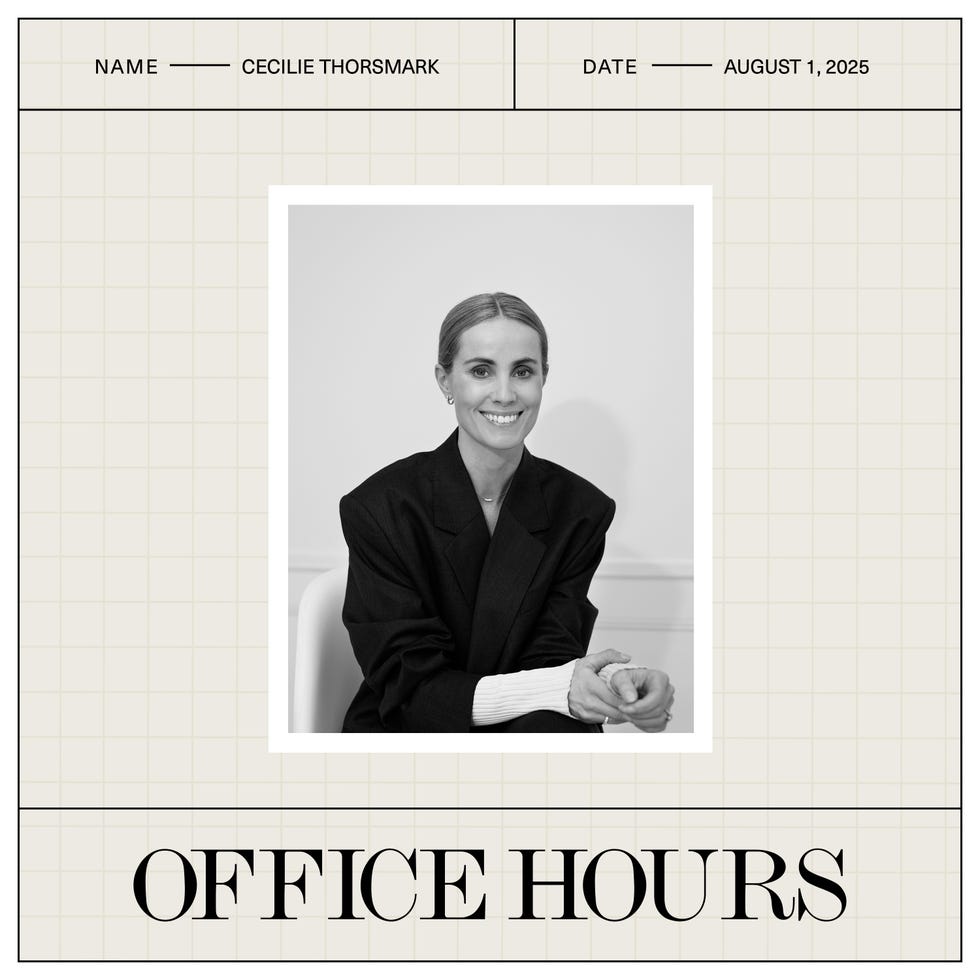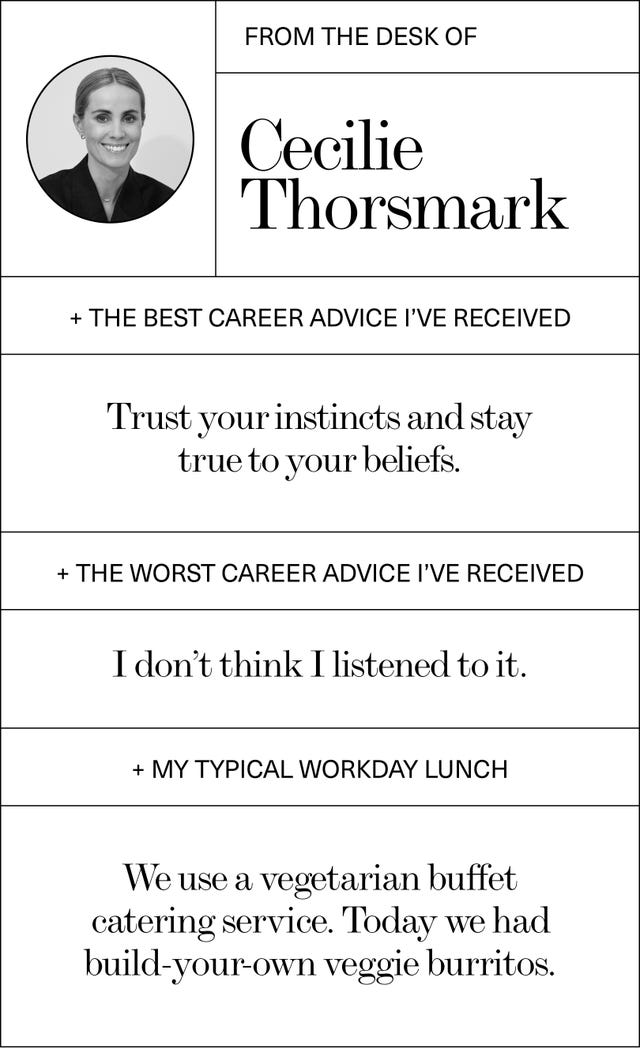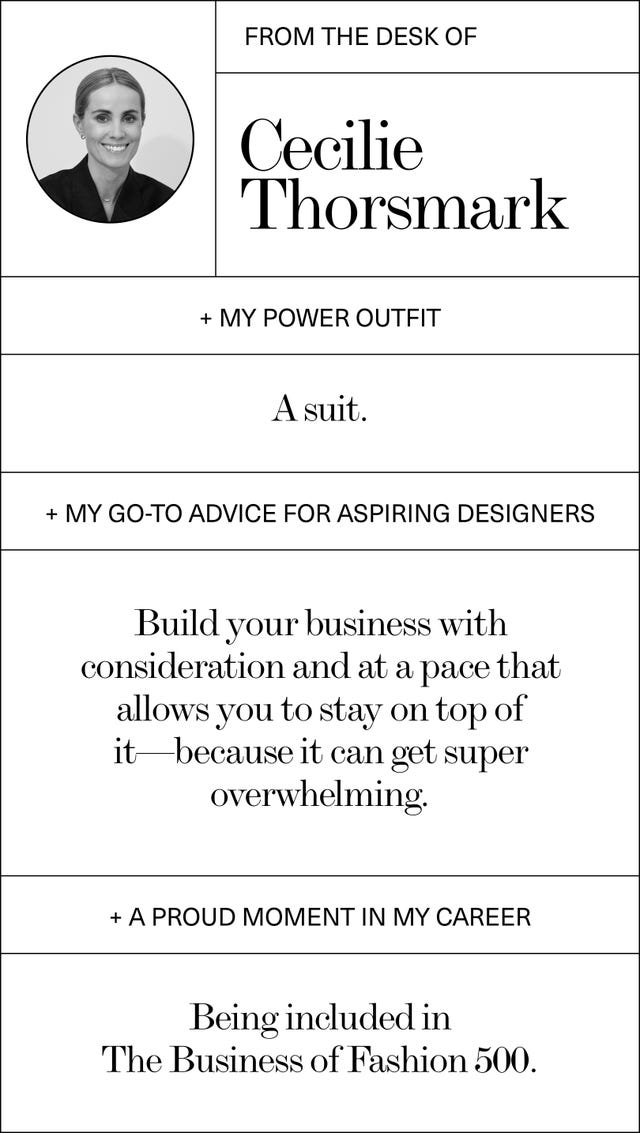How Cecilie Thorsmark Made Copenhagen a Must-Visit Stop on the Fashion Calendar


In ELLE’s monthly series Office Hours, we ask people in powerful positions to take us through their first jobs, worst jobs, and everything in between. This month, we sat down with Cecilie Thorsmark, the CEO of Copenhagen Fashion Week (CPHFW), which has experienced a meteoric rise under her leadership. “The reason I applied to be CEO of Copenhagen Fashion Week was that I saw huge potential to challenge the status quo—not just of fashion weeks in general, but their very purpose,” she says. “The industry lives in its own bubble, and very little attention is paid to the world around us. I wanted to see how we could use our platform as a force for change.” Here, she shares how she developed CPHFW’s Sustainability Requirements, a set of environmental standards for brands; highlights emerging designers she’s excited about; and reveals how she unwinds after a (very) busy week.
My first jobMy first job was at a local fashion shop in Hornbæk, a seaside town in Denmark known for its summer residences. I must have been around 13 years old—eager to earn my first paycheck. I folded clothes, helped customers, and essentially learned the basics of retail. It was my introduction to the fashion world—and probably the only clothing store in that small town!
My worst jobIronically, the two worst jobs I’ve had were outside the fashion industry at advertising agencies—and in both cases, the culture was so male-dominated it bordered on harassment. At the first agency, there was a very ill-tempered CEO and an all-female staff, and the atmosphere was patronizing and demoralizing. At the second, I was the only female among all-male colleagues. It was definitely a strange and uncomfortable culture to be part of. Those experiences taught me what kind of work environment I never want to be in again. For me, work culture has always been—and remains—extremely important.
How I first became interested in fashionIt goes back to my childhood. I grew up in a family of creatives from all sorts of fields—furniture designers, architects, professional ballet dancers, and costume designers. My grandmother was a seamstress, and my appreciation for aesthetics is grounded in our family legacy. I remember my grandmother’s closet—she had the most amazing handmade garments and the most breathtaking collection of silk pumps in every color.

The reason I applied to be CEO of Copenhagen Fashion Week was that I saw huge potential to challenge the status quo—not just of fashion weeks in general, but their very purpose. I’ve always been very dedicated to environmental issues and climate issues. My father worked in the Ministry of the Environment for over 30 years, so these were the kinds of conversations we always had around the dinner table—about how to be more conscious. The industry lives in its own bubble, and very little attention is paid to the world around us. We face some very big challenges, especially with our environmental footprint. I wanted to see how we could use our platform as a force for change. That’s why we developed our Sustainability Requirements.
How I turned CPHFW into a hub for sustainable fashionMy proudest moment has definitely been the successful implementation [of the Sustainability Requirements]. We started developing the framework and creating criteria based on various sustainability elements back in 2019. In 2020, we announced that by 2023 these Sustainability Requirements would come into effect. We had three years to get the support of the industry to make such radical change, but more importantly, we focused on making sure that brands had the knowledge and tools needed to live up to the standards. Because, ultimately, it would’ve failed big time if we’d only been able to approve five brands—we probably wouldn’t have even had a fashion week at all. If we want to drive change in the industry, then we need to work broadly with the industry. And in 2023, we pulled it off—we had a full fashion week schedule with brands that all met our Sustainability Requirements.
On what sets Scandi style apartIt’s very much focused on functionality and quality, paired with a great level of aesthetics. Our culture is influenced by democratic values—we’re all equal, we all bike to work, we all take our kids to their institutions—and I think that requires a wardrobe that is not only aesthetically pleasing but also functional.
My leadership style as CEOA quote I’ve always adhered to throughout my career is by Maya Angelou: “People will not remember what you said or what you did; they will remember how you made them feel.” That’s been a kind of moral compass for me, both in my relationships with colleagues and stakeholders, and especially as a leader with my team. Leadership, to me, is just as much about emotional intelligence as it is about strategy and decision-making.

As cliché as it sounds, standing up for what you believe in is crucial. If you decide to work with purpose, you have to anchor everything around that purpose and let it inform every decision—big or small. Don’t be afraid of criticism or of people who think they know better. Trust your instincts.
On fashion’s sustainability problemOne crucial element we need to focus on in order to make real change in the fashion industry is implementing circular business models. Overproduction remains our biggest challenge, so we have to find ways to combat it—either by lowering volumes or adopting more circular principles in how we operate and produce.
The emerging Scandinavian designers on my radar right nowThere are more established names like OpéraSport, The Garment, ROTATE, and Forza Collective, as well as emerging designers from our NEWTALENT program, including Bonnetje, Berner Kühl, and Anne Sofie Madsen.
How I unwind after fashion weekHave no plans at all and just be with my kids and family. Ideally, we’d be at our summer house in Rørvig, near the beach and the woods—soaking up nature and getting as far away from the fashion world as possible.
This interview has been edited and condensed for clarity.
elle




